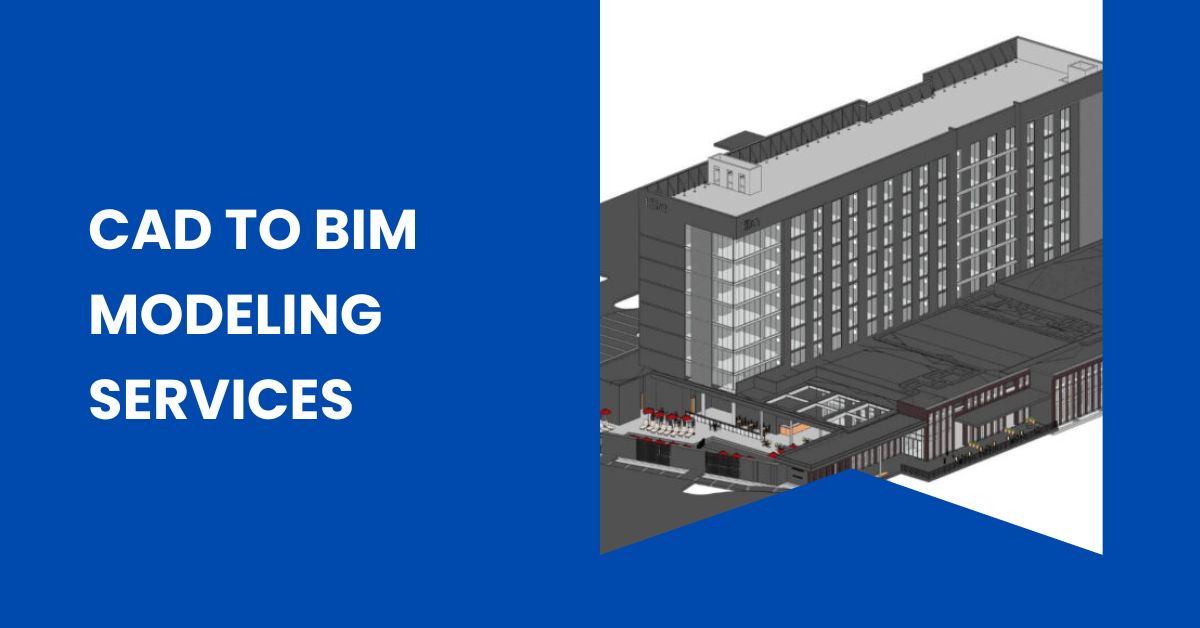In today’s fast-evolving AEC (Architecture, Engineering, and Construction) industry, technology continues to redefine the way buildings are planned, designed, and built. One of the most impactful shifts is the transition from traditional CAD (Computer-Aided Design) to BIM (Building Information Modeling). CAD to BIM modeling services are playing a crucial role in enhancing project efficiency, cross-functional collaboration, and cost control for construction professionals, architects, and engineers around the globe.
In this detailed blog, we’ll explore what CAD to BIM modeling services entail, why they matter, the process of conversion, and how they are shaping the future of building design and project execution in the digital age.
What is CAD to BIM Conversion?
CAD to BIM modeling is the process of converting 2D CAD drawings (usually in DWG, DXF, or DGN formats) or basic 3D CAD models into intelligent, data-rich BIM models using software such as Autodesk Revit, ArchiCAD, or Bentley Systems. This digital transformation is essential for better project visualization and coordination.
While CAD provides geometric and schematic representations of architectural and engineering designs, BIM adds multiple layers of real-time data and attributes such as materials, quantities, structural load details, dimensions, costs, timelines, and even energy performance. BIM isn’t just about 3D modeling—it creates a comprehensive digital twin of a building that enhances every phase of the building lifecycle, from design to demolition and facility maintenance.
Why Transition from CAD to BIM?
1. Enhanced Collaboration:
BIM provides a centralized digital model that all stakeholders—architects, structural engineers, MEP consultants, and contractors—can access, edit, and update simultaneously in real-time. This level of collaboration significantly reduces miscommunication, coordination errors, and design conflicts during the planning and execution stages.
2. Improved Accuracy:
CAD drawings are often fragmented and rely heavily on manual updates, making them prone to human errors and inconsistencies. BIM’s intelligent modeling capabilities automatically detect clashes between systems (like ductwork vs. beams), identify discrepancies, and prevent costly revisions later in the project.
3. Lifecycle Management:
BIM supports the entire building lifecycle—from initial concept to post-construction facility management. It enables smoother maintenance, retrofitting, and renovation with precise, up-to-date digital information for owners, property managers, and maintenance teams.
4. Cost Savings:
By detecting design errors early, improving estimation accuracy, and optimizing resource planning, BIM helps significantly reduce construction delays, material wastage, and rework—leading to better profitability and client satisfaction.
How CAD to BIM Modeling Services Work
The conversion process is typically carried out by BIM experts or specialized service providers who understand industry standards and deliverables. Here’s a breakdown of how a standard CAD to BIM conversion project usually unfolds:
1. Data Collection and CAD Analysis
The first step involves collecting all relevant CAD files, including 2D plans, elevations, sections, and sometimes scanned blueprints or PDFs. The modeling team reviews the input data carefully to understand project goals, required LOD (Level of Detail), and any architectural or engineering standards that need to be followed.
2. BIM Modeling in Revit or Similar Software
Based on the client’s specifications and project scope, professionals create a 3D BIM model using tools like Autodesk Revit, ArchiCAD, or Allplan. The model includes architectural, structural, and MEP (Mechanical, Electrical, Plumbing) components, with detailed parameters and real-world properties embedded for every element.
3. Quality Checks and Clash Detection
The completed model goes through strict quality assurance processes. Clash detection tools like Navisworks are used to identify and resolve conflicts within systems (HVAC, structural, plumbing). This ensures that the final BIM model is accurate, compliant, and construction-ready.
4. Documentation and Delivery
Finally, the model is delivered in formats like .RVT, .IFC, .NWD, or .PDF, based on the client’s needs. In addition to the 3D model, 2D documentation such as floor plans, elevations, sections, schedules, and BOQs (Bill of Quantities) can also be extracted for construction or permitting.
Read more: Transforming AutoCAD to BIM Services
Industries That Benefit from CAD to BIM Modeling
- Architecture Firms: Convert schematic CAD drawings into fully coordinated, parametric BIM models for smoother design development and client presentations.
- Engineering Consultancies: Integrate structural and MEP components for real-time coordination and reduce conflicts between design disciplines.
- Construction Companies: Get accurate quantity takeoffs, better scheduling, and site execution plans derived from BIM for on-time project delivery.
- Facility Managers: Use BIM for efficient space management, asset tracking, and predictive maintenance of building systems post-construction.
- Real Estate Developers: Leverage BIM for 3D walkthroughs, stakeholder presentations, sales pitches, and energy performance simulation for green certifications.
Benefits of CAD to BIM Modeling Services
- Time Efficiency: Automated BIM modeling drastically reduces the time spent on manual drafting, updates, and revisions.
- Design Accuracy: Eliminate coordination errors and reduce RFIs (Requests for Information) during construction by detecting design conflicts early.
- Informed Decisions: Data-rich models support smarter decision-making regarding materials, energy use, budgeting, and project phasing.
- Scalability: BIM models can be scaled for use in larger commercial projects or modular construction developments with ease.
- Sustainability: Integrate simulation data into BIM for sustainable design, LEED certification, and long-term environmental impact analysis.
Choosing the Right CAD to BIM Service Provider
Not all BIM modeling service providers are created equal. To ensure a successful CAD to BIM transition, consider working with a provider who:
- Has strong experience in your project type (residential, commercial, industrial, healthcare, etc.)
- Is skilled in advanced BIM platforms such as Revit, Navisworks, Tekla, or Vectorworks
- Understands LOD levels (100 to 500) and delivers BIM outputs based on your requirements
- Offers clear communication, quality control protocols, and references from successful past clients
- Can support your project beyond modeling, including BIM coordination, documentation, and clash detection
Conclusion
As digital transformation accelerates in the construction industry, CAD to BIM modeling services are becoming not just an option—but a necessity. Whether you are digitizing legacy designs or planning a new project from the ground up, BIM offers better coordination, reduced risks, improved efficiency, and data-driven decision-making.
If your team is still working with 2D CAD drawings, it’s time to evolve. BIM isn’t just a tool—it’s a smarter way to build, manage, and maintain buildings for decades to come.
Also read: Plumbing Riser Diagram Services: Essential for Smart Building Design



